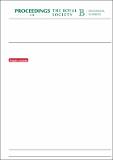Por favor, use este identificador para citar o enlazar a este item:
http://hdl.handle.net/10261/99270COMPARTIR / EXPORTAR:
 SHARE SHARE
 CORE
BASE CORE
BASE
|
|
| Visualizar otros formatos: MARC | Dublin Core | RDF | ORE | MODS | METS | DIDL | DATACITE | |

| Campo DC | Valor | Lengua/Idioma |
|---|---|---|
| dc.contributor.author | Schunter, C. | - |
| dc.contributor.author | Pascual, Marta | - |
| dc.contributor.author | Garza, J. C. | - |
| dc.contributor.author | Raventós, Núria | - |
| dc.contributor.author | Macpherson, Enrique | - |
| dc.date.accessioned | 2014-07-02T07:54:33Z | - |
| dc.date.available | 2014-07-02T07:54:33Z | - |
| dc.date.issued | 2014 | - |
| dc.identifier.citation | Proceedings of the Royal Society B 281 : 20140556 (2014) | es_ES |
| dc.identifier.issn | 0962-8452 | - |
| dc.identifier.uri | http://hdl.handle.net/10261/99270 | - |
| dc.description | 7 páginas, 3 figuras. | es_ES |
| dc.description.abstract | Connectivity is crucial for the persistence and resilience of marine species, the establishment of networks of marine protected areas and the delineation of fishery management units. In the marine environment, understanding connectivity is still a major challenge, due to the technical difficulties of tracking larvae. Recently, parentage analysis has provided a means to address this question effectively. To be effective, this method requires limited adult movement and extensive sampling of parents, which is often not possible for marine species. An alternative approach that is less sensitive to constraints in parental movement and sampling could be the reconstruction of sibships. Here, we directly measure connectivity and larval dispersal in a temperate marine ecosystem through both analytical approaches. We use data from 178 single nucleotide polymorphism markers to perform parentage and sibship reconstruction of the black-faced blenny (Tripterygion delaisi) from an open coastline in the Mediterranean Sea. Parentage analysis revealed a decrease in dispersal success in the focal area over 1 km distance and approximately 6.5% of the juveniles were identified as self-recruits. Sibship reconstruction analysis found that, in general, full siblings did not recruit together to the same location, and that the largest distance between recruitment locations was much higher (11.5 km) than found for parent– offspring pairs (1.2 km). Direct measurements of dispersal are essential to understanding connectivity patterns in different marine habitats, and show the degree of self-replenishment and sustainability of populations of marine organisms.We demonstrate that sibship reconstruction allows direct measurements of dispersal and family structure in marine species while being more easily applied in those species for which the collection of the parental population is difficult or unfeasible. | es_ES |
| dc.description.sponsorship | This work was partially funded by the Spanish Ministry of Science and Innovation through the BENTHOMICS (CTM2010-22218-C02-01-02) projects and the FBBVA project (BIOCON 08-187?09). The authors C.S., M.P. and E.M. are part of the research group 2009SGR-636 and 2009SGR-665 of the Generalitat de Catalunya, and C.S. was funded by a JAE-Predoctoral Fellowship. | es_ES |
| dc.language.iso | eng | es_ES |
| dc.publisher | Royal Society (Great Britain) | es_ES |
| dc.rights | openAccess | es_ES |
| dc.subject | Sibship | es_ES |
| dc.subject | Tripterygion delaisi | es_ES |
| dc.subject | Parentage analysis | es_ES |
| dc.subject | Connectivity | es_ES |
| dc.subject | Dispersal | es_ES |
| dc.subject | Self-recruitment | es_ES |
| dc.title | Kinship analyses identify fish dispersal events on a temperate coastline | es_ES |
| dc.type | artículo | es_ES |
| dc.identifier.doi | 10.1098/rspb.2014.0556 | - |
| dc.description.peerreviewed | Peer reviewed | es_ES |
| dc.relation.publisherversion | http://dx.doi.org/10.1098/rspb.2014.0556 | es_ES |
| dc.relation.csic | Sí | es_ES |
| dc.identifier.pmid | 24812064 | - |
| dc.type.coar | http://purl.org/coar/resource_type/c_6501 | es_ES |
| item.openairetype | artículo | - |
| item.languageiso639-1 | en | - |
| item.fulltext | With Fulltext | - |
| item.grantfulltext | open | - |
| item.cerifentitytype | Publications | - |
| item.openairecristype | http://purl.org/coar/resource_type/c_18cf | - |
| Aparece en las colecciones: | (CEAB) Artículos | |
Ficheros en este ítem:
| Fichero | Descripción | Tamaño | Formato | |
|---|---|---|---|---|
| Proc. R. Soc. B-2014-Schunter-.pdf | 812,38 kB | Adobe PDF |  Visualizar/Abrir |
CORE Recommender
PubMed Central
Citations
11
checked on 29-abr-2024
SCOPUSTM
Citations
35
checked on 02-may-2024
WEB OF SCIENCETM
Citations
36
checked on 25-feb-2024
Page view(s)
331
checked on 10-may-2024
Download(s)
179
checked on 10-may-2024
Google ScholarTM
Check
Altmetric
Altmetric
Artículos relacionados:
NOTA: Los ítems de Digital.CSIC están protegidos por copyright, con todos los derechos reservados, a menos que se indique lo contrario.
